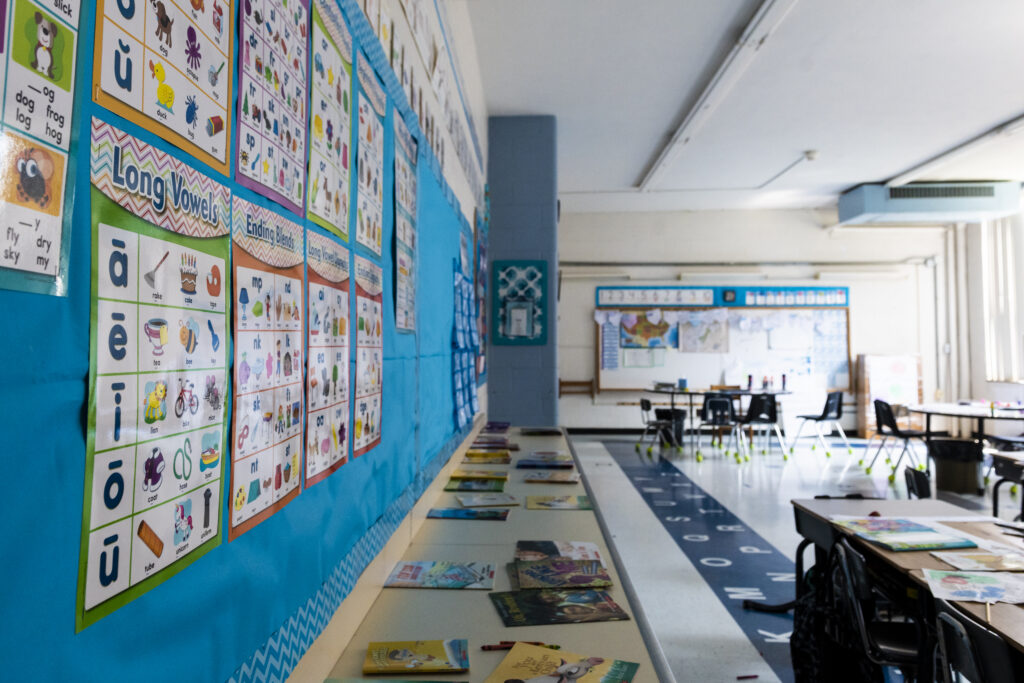
The West Virginia Board of Education voted on Wednesday, Nov. 13, 2024, to close or consolidate six schools in Kanawha County. (Lexi Browning | West Virginia Watch)
The state school board voted on Wednesday to close or consolidate six schools in Kanawha County as the district has lost thousands of students over the last few years. Statewide, 20 other schools could close next year as student population declines.
West Virginia’s overall population is declining, and thousands of students are opting to leave public schools for the Hope Scholarship, the state’s education savings account program.

School districts, including Kanawha, are struggling financially after losing some funding tied to the number of students they have. There could be 26 school closures this school year, MetroNews reported.
“We are at the point now where we cannot continue to cut positions without merging or consolidating,” Kanawha County Superintendent Tom Williams told school board members.
“I love kids. I want to see them have the best education they can get, and unfortunately, I’m only given X amount of dollars to do that with and I have to make that work.”
Parents and school board members expressed concerns about larger class sizes, longer bus routes and communities losing their schools.

“In this time of decreasing enrollment, county boards of education are having to make very difficult decisions,” said Nancy White, president of the West Virginia Board of Education. “Today is difficult, it’s painful, but it’s necessary. Counties cannot sustain operating at previous capacities while losing two-, three- or 4,000 students from its public schools. That’s what is happening.”
Kanawha County has lost 5,000 students over the past 11 years, equating to a $30 million drop in funding, according to Williams. More than 1,200 students left to use the Hope Scholarship.
The county’s excess levy hasn’t covered the necessary costs.
Williams said he’ll lose 39 school positions at the end of this year due to the continued student population decline.
“When making these difficult decisions for merger or consolidations, I had to first look at schools where this could occur without significant cost to the district,” Williams said.
The board approved a plan to close and consolidate Belle Elementary School, Mary Ingles Elementary School, Malden Elementary School and Midland Trail Elementary School. A new school is proposed to be built at the location of the former DuPont Junior High, which has been torn down. McKinley Middle School will be closed and merged into Hayes Middle School. East Bank Middle School will be closed and consolidated into DuPont Middle School.
Age of the buildings has been a factor in consolidation as well, according to Micah Whitlow, director of the WVDE’s Office of School Facilities. West Virginia school buildings are on average 50 years old.
“The average age of the schools that are being talked about for closure across the state is 63,” he said. “The facility doesn’t tell the whole picture but it’s a good indicator of when things need to move or maybe make some upgrades.”

Ahead of the vote, Republican Sens. Mike Stuart, R-Kanawha, and Rupie Phillips, R-Logan, sent letters to be read by others on their behalf that expressed unhappiness with proposals to close and consolidate schools.
“While I fully understand that these decisions are driven by fiscal responsibility and the need to address funding issues, I must emphasize that we cannot lose sight of the primary reason our public schools exist to serve the educational needs of our students,” Phillips wrote.

State school board member Paul Hardesty took issue with their statements, saying that their words “rang hollow” after a slew of legislation expanding school choice, including the nation’s broadest education savings account program. More than 9,000 students have been awarded the Hope Scholarship this school year; the program gives roughly $4,400 per student in taxpayer money to families to use for private school, homeschooling and more.
“If you want smaller schools, change the funding formula,” Hardesty said. “It’s not fair for people in elected positions to mess with people’s lives, to say they want one thing then do the opposite. They have created class warfare in public education.”
Debra Sullivan, a school board member, said that lawmakers can assess the state’s current funding formula, which allows the state contribution to follow the student — meaning the school loses it if a child leaves to use the Hope Scholarship. Governor-elect Patrick Morrisey, a Republican, said he wants to expand school choice in the state.
“I’m hoping that our legislators are really looking at what can be done to support our public schools and to put money into them because over 90% of West Virginia school age children are attending public schools,” she said. “That’s the future of our state, our leaders, our business people, our teachers, our parents. So we need to be putting our money on the horses that are going to have to run.”
YOU MAKE OUR WORK POSSIBLE.

